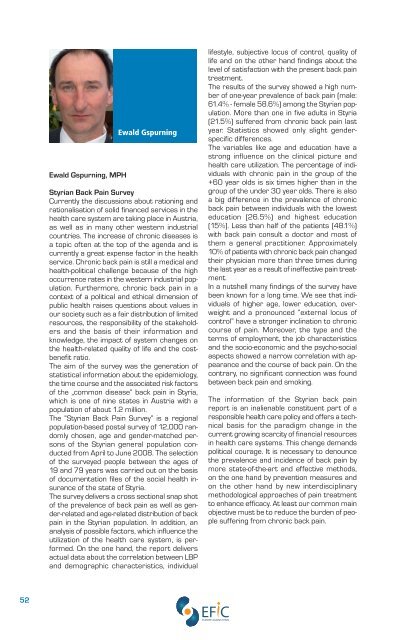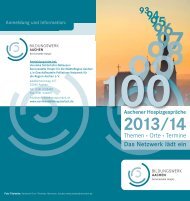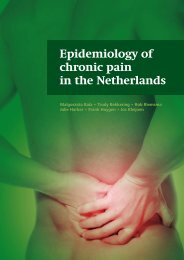First EFIC® Symposium Societal Impact of Pain - SIP
First EFIC® Symposium Societal Impact of Pain - SIP
First EFIC® Symposium Societal Impact of Pain - SIP
Create successful ePaper yourself
Turn your PDF publications into a flip-book with our unique Google optimized e-Paper software.
52<br />
Ewald Gspurning, MPH<br />
Ewald Gspurning<br />
Styrian Back <strong>Pain</strong> Survey<br />
Currently the discussions about rationing and<br />
rationalisation <strong>of</strong> solid financed services in the<br />
health care system are taking place in Austria,<br />
as well as in many other western industrial<br />
countries. The increase <strong>of</strong> chronic diseases is<br />
a topic <strong>of</strong>ten at the top <strong>of</strong> the agenda and is<br />
currently a great expense factor in the health<br />
service. Chronic back pain is still a medical and<br />
health-political challenge because <strong>of</strong> the high<br />
occurrence rates in the western industrial population.<br />
Furthermore, chronic back pain in a<br />
context <strong>of</strong> a political and ethical dimension <strong>of</strong><br />
public health raises questions about values in<br />
our society such as a fair distribution <strong>of</strong> limited<br />
resources, the responsibility <strong>of</strong> the stakeholders<br />
and the basis <strong>of</strong> their information and<br />
knowledge, the impact <strong>of</strong> system changes on<br />
the health-related quality <strong>of</strong> life and the costbenefit<br />
ratio.<br />
The aim <strong>of</strong> the survey was the generation <strong>of</strong><br />
statistical information about the epidemiology,<br />
the time course and the associated risk factors<br />
<strong>of</strong> the „common disease“ back pain in Styria,<br />
which is one <strong>of</strong> nine states in Austria with a<br />
population <strong>of</strong> about 1.2 million.<br />
The “Styrian Back <strong>Pain</strong> Survey” is a regional<br />
population-based postal survey <strong>of</strong> 12,000 randomly<br />
chosen, age and gender-matched persons<br />
<strong>of</strong> the Styrian general population conducted<br />
from April to June 2008. The selection<br />
<strong>of</strong> the surveyed people between the ages <strong>of</strong><br />
19 and 79 years was carried out on the basis<br />
<strong>of</strong> documentation files <strong>of</strong> the social health insurance<br />
<strong>of</strong> the state <strong>of</strong> Styria.<br />
The survey delivers a cross sectional snap shot<br />
<strong>of</strong> the prevalence <strong>of</strong> back pain as well as gender-related<br />
and age-related distribution <strong>of</strong> back<br />
pain in the Styrian population. In addition, an<br />
analysis <strong>of</strong> possible factors, which influence the<br />
utilization <strong>of</strong> the health care system, is performed.<br />
On the one hand, the report delivers<br />
actual data about the correlation between LBP<br />
and demographic characteristics, individual<br />
lifestyle, subjective locus <strong>of</strong> control, quality <strong>of</strong><br />
life and on the other hand findings about the<br />
level <strong>of</strong> satisfaction with the present back pain<br />
treatment.<br />
The results <strong>of</strong> the survey showed a high number<br />
<strong>of</strong> one-year prevalence <strong>of</strong> back pain (male:<br />
61.4% - female 58.6%) among the Styrian population.<br />
More than one in five adults in Styria<br />
(21.5%) suffered from chronic back pain last<br />
year. Statistics showed only slight genderspecific<br />
differences.<br />
The variables like age and education have a<br />
strong influence on the clinical picture and<br />
health care utilization. The percentage <strong>of</strong> individuals<br />
with chronic pain in the group <strong>of</strong> the<br />
+60 year olds is six times higher than in the<br />
group <strong>of</strong> the under 30 year olds. There is also<br />
a big difference in the prevalence <strong>of</strong> chronic<br />
back pain between individuals with the lowest<br />
education (26.5%) and highest education<br />
(15%). Less than half <strong>of</strong> the patients (48.1%)<br />
with back pain consult a doctor and most <strong>of</strong><br />
them a general practitioner. Approximately<br />
10% <strong>of</strong> patients with chronic back pain changed<br />
their physician more than three times during<br />
the last year as a result <strong>of</strong> ineffective pain treatment.<br />
In a nutshell many findings <strong>of</strong> the survey have<br />
been known for a long time. We see that individuals<br />
<strong>of</strong> higher age, lower education, overweight<br />
and a pronounced “external locus <strong>of</strong><br />
control” have a stronger inclination to chronic<br />
course <strong>of</strong> pain. Moreover, the type and the<br />
terms <strong>of</strong> employment, the job characteristics<br />
and the socio-economic and the psycho-social<br />
aspects showed a narrow correlation with appearance<br />
and the course <strong>of</strong> back pain. On the<br />
contrary, no significant connection was found<br />
between back pain and smoking.<br />
The information <strong>of</strong> the Styrian back pain<br />
report is an inalienable constituent part <strong>of</strong> a<br />
responsible health care policy and <strong>of</strong>fers a technical<br />
basis for the paradigm change in the<br />
current growing scarcity <strong>of</strong> financial resources<br />
in health care systems. This change demands<br />
political courage. It is necessary to denounce<br />
the prevalence and incidence <strong>of</strong> back pain by<br />
more state-<strong>of</strong>-the-art and effective methods,<br />
on the one hand by prevention measures and<br />
on the other hand by new interdisciplinary<br />
methodological approaches <strong>of</strong> pain treatment<br />
to enhance efficacy. At least our common main<br />
objective must be to reduce the burden <strong>of</strong> people<br />
suffering from chronic back pain.






